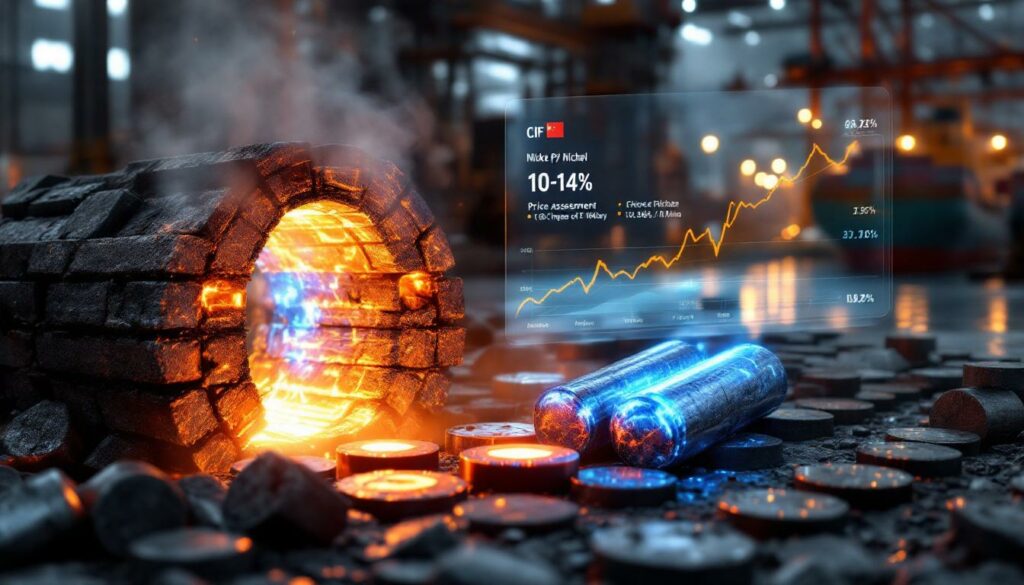Understanding Nickel Pig Iron CIF China Price Assessment: A Comprehensive Guide
What is Nickel Pig Iron and Why is it Important?
Nickel Pig Iron (NPI) has emerged as a revolutionary material in the stainless steel industry over the past decade. This iron-nickel alloy contains between 10-14% nickel content and serves as a cost-effective alternative to pure nickel in steel production. The composition typically includes 80% iron with strict limitations on impurities: phosphorus (≤0.04%), sulfur (≤0.4%), silicon (≤4.5%), and carbon (≤4%).
The production process involves smelting lateritic nickel ore in specialized blast or electric-arc furnaces. Unlike traditional ferronickel, NPI maintains a higher iron content, which integrates directly into stainless steel chemistry—making it particularly valuable for producers seeking cost efficiencies without sacrificing quality.
"Nickel pig iron is a key feedstock material used for stainless steel production, offering manufacturers significant cost advantages while maintaining essential metallurgical properties." — Fastmarkets Pricing Notice, 2025
The Fundamentals of Nickel Pig Iron
NPI comes in two primary varieties: high-grade (10-14% nickel) and low-grade (4-6% nickel). The high-grade variant, which is the focus of Fastmarkets' new price assessment, requires more sophisticated production techniques and careful ore blending to achieve target specifications. This premium material commands a higher price but delivers superior performance in stainless steel applications.
The production process involves several key stages:
- Mining lateritic nickel ore (typically from Indonesia or the Philippines)
- Preparing and blending the ore to achieve target composition
- Smelting in specialized furnaces at temperatures exceeding 1500°C
- Casting into ingots or granules for transport
- Quality testing to verify nickel content and impurity levels
While raw nickel trades on the London Metal Exchange (LME) at premium prices, NPI typically trades at a 50-70% discount, making it exceptionally attractive for stainless steel manufacturers operating with tight margins.
Strategic Importance in Steel Production
NPI has fundamentally transformed the economics of stainless steel production, particularly in China, which consumes approximately 60% of global nickel supply. Several factors contribute to its strategic importance:
- Cost advantage: NPI reduces production costs by 15-25% compared to pure nickel inputs
- Supply chain resilience: Reduces dependency on Class 1 nickel supplies, which can face volatility
- Value-chain integration: Enables vertical integration strategies for major producers
- Regional development: Drives economic growth in nickel-rich regions like Indonesia
Indonesia has leveraged its vast lateritic nickel resources to dominate global NPI production, accounting for approximately 85% of supply in 2024. This strategic pivot from ore exports to value-added NPI production has reshaped global nickel markets and created new price dynamics that necessitate dedicated assessment mechanisms. The mining industry evolution has accelerated these transformations in recent years.
Why is a CIF China Price Assessment Needed?
The nickel pig iron market has undergone significant structural changes in recent years, with China transitioning from a predominantly domestic production model to one heavily reliant on imports. This fundamental shift has created new pricing complexities that existing assessment methodologies struggle to capture.
Evolution of NPI Trading Methods
Over the past five years, China's NPI landscape has transformed dramatically. In 2020, only 15% of China's NPI consumption came from imports. By 2025, this figure exceeded 40%, driven by Indonesia's export policies favoring processed materials over raw ore exports. This shift has elevated CIF (Cost, Insurance, and Freight) as the dominant trading methodology for cross-border NPI transactions.
"CIF has grown to become one of the mainstream trading methods for the Chinese market," notes Fastmarkets in their July 2025 pricing notice. This evolution reflects the market's maturation and growing sophistication.
The existing assessment framework presents several limitations:
- Spot assessments: Capture domestic Chinese transactions but miss import dynamics
- DDP China prices: Include variable customs clearance costs that obscure underlying values
- FOB Indonesia assessments: Exclude critical freight and insurance components
These gaps create significant price discovery challenges, particularly as freight rates between Indonesia and China have fluctuated by up to 50% in 2025 alone, according to Baltic Dry Index data.
Benefits of the New Price Assessment
The introduction of a dedicated CIF China price assessment addresses several market needs:
- Enhanced transparency: Provides visibility into actual delivered costs before customs clearance
- Risk management: Enables more accurate hedging of international NPI shipments
- Contract standardization: Creates a reliable reference point for term contracts
- Market efficiency: Reduces information asymmetry between buyers and sellers
For traders managing shipments from Indonesia to Chinese ports like Tianjin, Ningbo, and Fangchenggang, the assessment offers critical visibility into price components that were previously opaque or subject to significant estimation error.
"This new assessment will allow Fastmarkets to bring more transparency to the Chinese NPI market at a time when import volumes are reaching historic highs." — Fastmarkets Pricing Notice, 2025
The price assessment also brings NPI in line with other key steel raw materials that already benefit from established CIF China assessments, creating a more cohesive analytical framework for market participants.
How Will the New Price Assessment Work?
Fastmarkets' new NPI CIF China price assessment follows a rigorous methodology designed to capture market realities while ensuring consistency and reliability. The specifications have been carefully calibrated to reflect actual trading practices and material quality requirements.
Detailed Assessment Specifications
The assessment will cover the following specific parameters:
| Parameter | Specification |
|---|---|
| Quality | Lump. Ni 10-14%, Fe 80%, P 0.04% max, S 0.4% max, Si 4.5% max, C 4% max |
| Quantity | Minimum 500 tonnes per transaction |
| Location | CIF main ports China |
| Timing | Spot market focus |
| Currency/Unit | Yuan per nickel unit |
| Publication | Weekly (Fridays at 3pm London time) |
These specifications target high-grade NPI, which represents the premium segment of the market. The 10-14% nickel content range aligns with the most commonly traded material for stainless steel production, while the impurity limits ensure consistency with industry acceptance standards.
The assessment will be expressed in yuan per nickel unit rather than per tonne of NPI, which normalizes for variations in nickel content within the specified range. This approach is consistent with industry pricing conventions and facilitates direct comparison with other nickel-bearing materials.
Data Collection Methodology
Fastmarkets will employ a multi-faceted approach to data collection:
- Direct submissions: Market participants can submit transaction data via a standardized process
- Market intelligence: Fastmarkets' global team of reporters will gather price information
- Verification processes: Submitted data undergoes rigorous checks for accuracy and credibility
- Normalization techniques: Adjustments for payment terms, volume, and quality variations
The assessment will prioritize actual transactions but may incorporate bids, offers, and assessments from knowledgeable market participants during low-liquidity periods, following Fastmarkets' established hierarchy of data inputs.
For quality variations within the specified range, normalization will account for the precise nickel content. For example, a transaction at 12% nickel will be mathematically adjusted to ensure comparability with material at different nickel percentages.
Disclaimer: The price assessment represents Fastmarkets' judgment of prevailing market conditions at the time of publication. While every effort is made to ensure accuracy, market volatility and potential information gaps may affect the precision of any individual assessment.
What Market Trends are Driving This Development?
The introduction of this new price assessment comes amid significant shifts in global nickel markets, particularly the evolving relationship between Indonesian production and Chinese consumption. Understanding these trends provides essential context for the timing and importance of the new CIF China assessment.
China's NPI Import Dynamics
China's domestic NPI production has faced mounting pressure from environmental regulations and rising electricity costs, creating a growing dependency on imports. This trend has accelerated dramatically, with imports increasing 210% year-over-year in Q1 2025 according to China Customs data.
The import profile shows overwhelming Indonesian dominance, with over 92% of China's NPI imports originating from Indonesian smelters in 2025 (Mysteel). This concentration creates unique pricing dynamics that require specialized assessment methodologies.
Key factors influencing China's import patterns include:
- Cost differentials: Indonesian NPI production costs approximately $200/tonne less than Chinese domestic production
- Quality advantages: Indonesian material typically offers more consistent nickel content
- Environmental arbitrage: Stricter Chinese emissions standards have shifted production offshore
- Policy influences: Indonesia's ban on nickel ore exports has accelerated downstream investment
These trends appear set to continue, with several major Chinese steel producers securing long-term offtake agreements with Indonesian NPI facilities through 2030, signaling the market's structural shift toward an import-dependent model. The iron ore price trends provide important context for understanding these shifts in metal markets.
Supply Chain Considerations
The logistics of moving NPI from Indonesia to China introduce significant cost variables that affect delivered prices. These factors include:
- Freight rates: Capesize vessel rates for Indonesia-China routes rose 37% between January and July 2025
- Fuel costs: Bunker fuel price volatility directly impacts CIF pricing
- Port congestion: Processing delays at major Chinese ports can add $5-10/tonne in demurrage costs
- Shipping availability: Limited specialized vessel capacity during peak periods can create premiums
For importers, these logistics considerations can represent 8-12% of the total delivered cost, making them critical components of accurate price discovery. The CIF assessment methodology specifically addresses these factors by capturing the full delivered cost to Chinese ports before customs clearance.
Weather patterns in the South China Sea also introduce seasonal volatility to freight rates, with typhoon season (June-November) typically adding a risk premium to shipping costs that flows through to CIF prices.
How Does This Assessment Compare to Existing Price Benchmarks?
Fastmarkets has been tracking various NPI price points since 2014, creating a comprehensive ecosystem of assessments. The new CIF China price will complement these existing benchmarks, filling a critical gap in the price discovery landscape.
Comparison with Other NPI Price Assessments
The table below outlines the key differences between Fastmarkets' NPI price assessments:
| Assessment | Inception | Focus | Key Differentiator |
|---|---|---|---|
| Spot China | 2014 | Domestic transactions | Captures local market dynamics |
| DDP China | 2014 | Delivered including duty | Includes customs clearance costs |
| FOB Indonesia | 2023 | Export prices | Excludes freight and insurance |
| CIF China (new) | 2025 | Delivered before customs | Captures full import cost structure |
Each assessment serves a specific market need and provides different visibility into the value chain. The spot and DDP assessments primarily reflect domestic Chinese market conditions, while the FOB Indonesia assessment captures export pricing at origin.
The new CIF China assessment bridges a critical gap between FOB Indonesia and DDP China prices by isolating the delivered cost before customs procedures. This provides valuable insight into the true economics of importing NPI and enables more accurate comparison between domestic and imported material.
Integration with Steel Raw Materials Package
This new assessment will be incorporated into Fastmarkets' comprehensive steel raw materials package, enabling integrated analysis with other key inputs:
- Correlation analysis: Relationships between NPI and other nickel sources
- Substitution economics: Comparative value modeling against ferronickel and nickel cathode
- Stainless steel cost modeling: Integrated production cost calculations
- Forward curve development: Enhanced forecasting capabilities
For market analysts, the inclusion of CIF China NPI prices completes the picture of stainless steel input costs, allowing for more sophisticated margin analysis and strategic planning. This integration addresses a longstanding analytical gap in the steel raw materials suite. Moreover, understanding the iron ore forecast analysis helps contextualize nickel market dynamics within the broader metals landscape.
What is the Implementation Timeline?
Fastmarkets has outlined a clear process for introducing this new price assessment, balancing the need for market input with the urgency of addressing the pricing transparency gap.
Consultation and Launch Process
The implementation follows a structured timeline:
- Consultation period: July 15 to August 12, 2025
- Feedback evaluation: August 12-14, 2025
- Proposed launch date: August 15, 2025
- First assessment publication: August 15, 2025 at 3pm London time
This timeline allows for approximately four weeks of market consultation, enabling stakeholders to provide input on the proposed methodology and specifications. Fastmarkets will evaluate all feedback received during this period and may make adjustments to the assessment design based on market consensus.
Important: Market participants are encouraged to submit feedback by August 12, 2025 to ensure consideration before the launch.
Adoption Considerations
For market participants looking to incorporate this new assessment into their operations, several implementation factors should be considered:
- Contract integration: Reviewing existing contracts for potential reference price updates
- Internal systems: Updating pricing models and risk management frameworks
- Comparative analysis: Establishing correlations with existing price references
- Transition period: Potential dual referencing during initial adoption
Organizations may wish to conduct parallel tracking during the initial assessment period to establish confidence in the new benchmark before fully integrating it into commercial agreements.
Fastmarkets will provide educational resources and direct support to market participants during the transition, including methodology workshops and data submission training.
How Can Market Participants Engage with the Assessment?
Active market participation is essential for robust price discovery. Fastmarkets encourages stakeholder engagement through multiple channels to ensure the assessment accurately reflects market realities.
Becoming a Data Submitter
Organizations involved in the physical NPI market can contribute to the assessment by becoming regular data submitters. The process includes:
- Initial registration: Contact Fastmarkets' price reporting team
- Submission guidelines: Review and implement structured data reporting procedures
- Regular reporting: Provide transaction details within specified timeframes
- Feedback loop: Receive confirmation of data receipt and processing
Eligible participants include producers, consumers, traders, and brokers actively involved in the physical NPI market. While all market participants are encouraged to submit data, Fastmarkets maintains strict confidentiality protocols to protect commercially sensitive information.
To become a data submitter, interested parties should contact Dylan Duan and Laura Li at pricing@fastmarkets.com with the subject line "NPI CIF China Assessment" as specified in the Fastmarkets Pricing Notice.
Using the Price Assessment
The assessment offers multiple applications across the value chain:
For producers:
- Benchmark performance against market averages
- Inform production and marketing strategies
- Structure term contracts with reference-based pricing
For traders:
- Evaluate arbitrage opportunities between regions
- Develop more accurate pricing models
- Manage position risk across different price points
For consumers:
- Optimize procurement strategies
- Compare domestic versus import economics
- Improve budget forecasting accuracy
The weekly publication schedule allows for regular portfolio valuation while providing sufficient stability for commercial applications. Many market participants are expected to incorporate the assessment into term contracts using monthly averages to smooth short-term volatility.
What Are the Broader Market Implications?
The introduction of a dedicated NPI CIF China price assessment represents more than just another data point—it signifies the market's evolution and maturation. The implications extend beyond immediate price discovery to fundamental market structure and efficiency.
Impact on Nickel Market Transparency
The nickel value chain has historically suffered from opacity at critical transfer points, particularly in intermediate products like NPI. This assessment addresses several longstanding transparency issues:
- Information asymmetry: Reduces the knowledge gap between large and small market participants
- Price formation: Creates a more robust mechanism for price discovery
- Market efficiency: Enables more accurate resource allocation decisions
- Investment signals: Provides clearer indicators for capacity planning
Enhanced transparency typically leads to narrower bid-ask spreads and more efficient price formation, benefiting all market participants. For the broader stainless steel industry, improved NPI pricing translates to more accurate production cost modeling and strategic planning. The potential for iron ore surplus decline could also impact related metal markets, including nickel.
Strategic Considerations for Market Participants
Organizations across the value chain should consider several strategic responses to this development:
For Indonesian producers:
- Reevaluate pricing strategies for different export markets
- Consider developing more sophisticated hedging approaches
- Analyze the impact on vertical integration economics
For Chinese importers:
- Reassess the import vs. domestic procurement balance
- Develop more granular landed cost models
- Explore index-linked contract structures
For traders and intermediaries:
- Identify new arbitrage opportunities between price points
- Develop enhanced risk management products
- Consider transparency-driven
Ready to Spot the Next Major Mineral Discovery?
Discover how the proprietary Discovery IQ model instantly alerts investors to significant ASX mineral discoveries, turning complex data into actionable insights. Explore why historic discoveries have generated substantial returns by visiting Discovery Alert's dedicated discoveries page and begin your 30-day free trial today.




